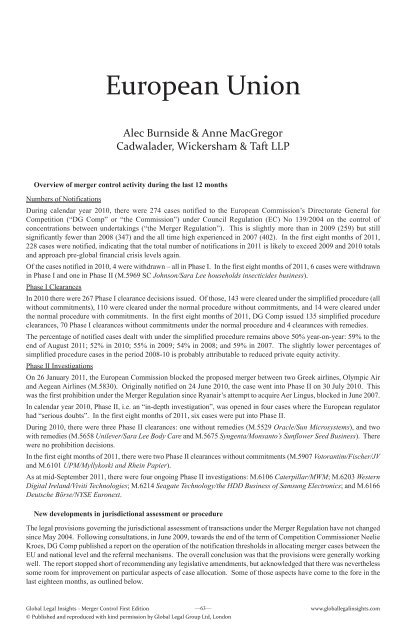Merger Controls First Edition - J Sagar Associates
Merger Controls First Edition - J Sagar Associates
Merger Controls First Edition - J Sagar Associates
Create successful ePaper yourself
Turn your PDF publications into a flip-book with our unique Google optimized e-Paper software.
European Union<br />
Alec Burnside & Anne MacGregor<br />
Cadwalader, Wickersham & Taft LLP<br />
Overview of merger control activity during the last 12 months<br />
Numbers of Notifications<br />
During calendar year 2010, there were 274 cases notified to the European Commission’s Directorate General for<br />
Competition (“DG Comp” or “the Commission”) under Council Regulation (EC) No 139/2004 on the control of<br />
concentrations between undertakings (“the <strong>Merger</strong> Regulation”). This is slightly more than in 2009 (259) but still<br />
significantly fewer than 2008 (347) and the all time high experienced in 2007 (402). In the first eight months of 2011,<br />
228 cases were notified, indicating that the total number of notifications in 2011 is likely to exceed 2009 and 2010 totals<br />
and approach pre-global financial crisis levels again.<br />
Of the cases notified in 2010, 4 were withdrawn – all in Phase I. In the first eight months of 2011, 6 cases were withdrawn<br />
in Phase I and one in Phase II (M.5969 SC Johnson/Sara Lee households insecticides business).<br />
Phase I Clearances<br />
In 2010 there were 267 Phase I clearance decisions issued. Of those, 143 were cleared under the simplified procedure (all<br />
without commitments), 110 were cleared under the normal procedure without commitments, and 14 were cleared under<br />
the normal procedure with commitments. In the first eight months of 2011, DG Comp issued 135 simplified procedure<br />
clearances, 70 Phase I clearances without commitments under the normal procedure and 4 clearances with remedies.<br />
The percentage of notified cases dealt with under the simplified procedure remains above 50% year-on-year: 59% to the<br />
end of August 2011; 52% in 2010; 55% in 2009; 54% in 2008; and 59% in 2007. The slightly lower percentages of<br />
simplified procedure cases in the period 2008-10 is probably attributable to reduced private equity activity.<br />
Phase II Investigations<br />
On 26 January 2011, the European Commission blocked the proposed merger between two Greek airlines, Olympic Air<br />
and Aegean Airlines (M.5830). Originally notified on 24 June 2010, the case went into Phase II on 30 July 2010. This<br />
was the first prohibition under the <strong>Merger</strong> Regulation since Ryanair’s attempt to acquire Aer Lingus, blocked in June 2007.<br />
In calendar year 2010, Phase II, i.e. an “in-depth investigation”, was opened in four cases where the European regulator<br />
had “serious doubts”. In the first eight months of 2011, six cases were put into Phase II.<br />
During 2010, there were three Phase II clearances: one without remedies (M.5529 Oracle/Sun Microsystems), and two<br />
with remedies (M.5658 Unilever/Sara Lee Body Care and M.5675 Syngenta/Monsanto’s Sunflower Seed Business). There<br />
were no prohibition decisions.<br />
In the first eight months of 2011, there were two Phase II clearances without commitments (M.5907 Votorantim/Fischer/JV<br />
and M.6101 UPM/Myllykoski and Rhein Papier).<br />
As at mid-September 2011, there were four ongoing Phase II investigations: M.6106 Caterpillar/MWM; M.6203 Western<br />
Digital Ireland/Viviti Technologies; M.6214 Seagate Technology/the HDD Business of Samsung Electronics; and M.6166<br />
Deutsche Börse/NYSE Euronext.<br />
New developments in jurisdictional assessment or procedure<br />
The legal provisions governing the jurisdictional assessment of transactions under the <strong>Merger</strong> Regulation have not changed<br />
since May 2004. Following consultations, in June 2009, towards the end of the term of Competition Commissioner Neelie<br />
Kroes, DG Comp published a report on the operation of the notification thresholds in allocating merger cases between the<br />
EU and national level and the referral mechanisms. The overall conclusion was that the provisions were generally working<br />
well. The report stopped short of recommending any legislative amendments, but acknowledged that there was nevertheless<br />
some room for improvement on particular aspects of case allocation. Some of those aspects have come to the fore in the<br />
last eighteen months, as outlined below.<br />
Global Legal Insights <strong>Merger</strong> Control <strong>First</strong> <strong>Edition</strong><br />
—63—<br />
© Published and reproduced with kind permission by Global Legal Group Ltd, London<br />
www.globallegalinsights.com


